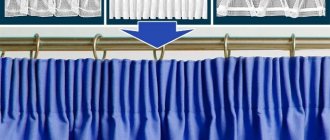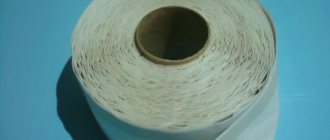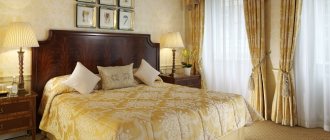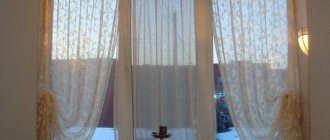It is very important that the curtains harmoniously frame the window, and that the folds beautifully and elegantly complement the interior decor. Curtain tape is often used to create this look. This is a special fitting that is used to form folds on drapes and curtains. They can be of different widths and shapes, translucent or white.
How to use curtain tapes is a natural question that arises immediately after housewives find out what this device is.
In the center of the curtain tape there are ready-made loops sewn in, which require fastening to special hooks. Hook loops can be sewn in two or three rows. Along the width of the fittings, several threads run parallel to each other, below and above: they are intended to create drapery.
At first glance, it is not clear how using translucent tape and ribbons you can get original folds on the curtains, how to secure it and what to do next.
Main purposes and advantages of curtain tape:
- Makes it possible to elegantly and simply create drapery on fabric of any texture.
- There is no need to sew on additional loops and hooks.
- Does not shrink, which allows you to wash the product in any mode.
- Reduces sewing time.
- Quickly and easily pulled together using threads on the sides.
- It is possible to adjust and fix the width of curtains and drapes.
Once you understand the topic a little, it won’t be difficult to drape a window beautifully.
Curtain tape is a decorative soft fitting used to create folds of different widths and configurations on fabric.
Curtain braid, varieties, description
Decorative braid is sewn on the front or back side of the product. It not only serves as a fold assembly, but also decorates the product. Original decorative braid for curtains can be sewn: on the bottom edge, along the perimeter, on the sides. It can be additionally decorated with stones, rhinestones, lurex, and beads.
Its use for window decoration has recently become very common among designers, needlewomen and curtain sewers.
Types of decorative braid:
- For buffs. This type creates a decorative drapery of a special shape. This technique looks great on plain materials, creating a corrugated effect.
- Ruffles. They are sewn onto the front side of the product. A country style curtain is the most common model using decorative fittings in the form of ruffles.
- With ornament. These are products with a variety of patterns and ethnic motifs. You can find decorative braid in Greek, Moroccan, African, English, Arabic, and Japanese styles. With the help of such a decorative detail, accents are placed and a special ethnic element in the interior is emphasized.
- With Fringe. Used in styles with lush decoration: art deco, classic, empire, Victorian, oriental style.
- Openwork with lurex. An original finish for curtains that will make the product elegant and complete.
This inconspicuous detail can turn even the most boring curtains into chic drapes.
Braid with loops
Tapes for curtains with loops are widely used; they are inexpensive and can be sewn to the back surface of curtains without much difficulty. Along the top and middle line of the product there are rows of loops for hooks. There may be several of them.
The most convenient thing about it is that it is made not of stretchy fabric, but of dense material.
- With two rows of loops. For normal hanging of curtains on hooks.
- With four rows of loops. For adjusting the length of curtains without shortening the edges.
Note! If the curtains sag, it means there are not enough curtain hooks and they are not designed correctly. The second reason: the braid is too thin and narrow.
It is easy to sew on a machine to the fabric, and the folds can be made of any density.
Braid with loops can be of two types:
- Transparent. Made from nylon, designed for light translucent fabrics: organza, veil, mesh. Such fittings will be invisible on thin and light fabric. The process of sewing transparent tape is more labor intensive and requires some experience and skill.
- Not transparent tape. Made from cotton for thick curtain fabrics. Before work, it is necessary to steam the tape to avoid unwanted shrinkage on the finished product.
Their size and quantity can be adjusted with several laces passed through the entire length of the tape.
Adhesive tape for curtains
The use of adhesive fittings for curtains is justified only if the material is light.
Curtain tape simplifies the process of sewing curtains.
The procedure for fixing the adhesive tape.
- Heat the strip with an iron; the high temperature will melt the glue on the tape to a liquid state.
- Carefully fix the tape on the curtain before the glue hardens: it is securely connected to the curtain.
It does not require sewing loops to secure the fabric to the hooks - these loops are already provided on the tape.
Curtain tapes
They are divided into two types according to the formation of types of assemblies.
- Horizontal assemblies. Used for sewing traditional curtains and lambrequins.
- Vertical assemblies. Used for sewing Roman, French and Austrian curtains with lifting mechanisms.
Curtain tape allows you to beautifully drape fabric of any density and texture.
What is curtain tape and why is it needed?
Curtain braid is a sewing accessory that is used when sewing curtains, drapes and drapes. It is attached to the upper edge of the product and performs several functions at once:
- Plays the role of fittings for attaching curtains to the cornice. Loops are sewn along the entire length of the curtain tape (sometimes in several rows). For them, the curtain is hung on hooks. Some curtain rods do not require the use of hooks. In this case, the cornice is passed through special rings or pinched with clothespins.
- Serves as a frame for folds and flounces. Inside the curtain tape there is one or more cords, when tightened, folds are formed. To create curly folds, there may be pockets on the tape. Also, the shape of the shuttlecocks depends on exactly how the cords are positioned.
- Strengthening the top of the curtain. It is on this section of the canvas that the greatest load falls. The braid prevents the curtains from deforming and tearing under their own weight.
The curtain can be sewn without special braid. However, such work will take more time and the result will be worse.
The tape is sewn onto the canvas when sewing a curtain or attached to a ready-made curtain without fittings. It is important to correctly calculate the size of the fabric element. It depends on the length of the cornice and the type of folds.
Curtain accessories are made from different materials. For curtains made from natural materials, cotton or linen strips of fabric are usually used; for heavy curtains, thick synthetic braid is purchased; for translucent curtains, thin, transparent tapes are chosen, which are almost invisible and easily hold weightless material.
Types of curtain tapes
The choice of braid for French and other curtains is huge. Curtain fittings vary according to the following parameters:
- Band width. Varies from 1.5 to 10 cm. The heavier the curtain, the wider the braid should be. Also, the width depends on the type of folds: the more complex they are, the more fabric will be required.
- Color. The most common options are white or transparent curtain tapes. The former are used for thick, opaque curtains, and the latter for light translucent curtains. There are decorative colored fittings. The shade of such braid can match the color of the curtains or be contrasting.
- Methods of attachment to the product. In stores there are sewn and glued options. In the first case, the curtain tape is attached to the curtain, and in the second, it is glued with an iron. Adhesive tape is less reliable than sew-on tape and is not suitable for heavy curtains.
- Fastening elements. The most popular are curtains with loops for hooks, which are created by a narrow ribbon sewn to the braid. There is braid with rings, Velcro, eyelets, clothespins, etc.
- Materials. To make braid, natural (cotton, linen) and artificial (polyester, cellulose) materials are used.
An important parameter by which curtain braid is classified is the type of folds:
- Harmonic. The simplest and most popular option. These are even symmetrical folds throughout the curtain. 1.5 is the coefficient, and 6 cm is the width.
- Shells. This option is used for heavy curtains. It is also called a wave. It is a round voluminous flounce on a curtain. This is a curtain tape with a width of 10 cm, the fitting factor is 2.
- Pencil. Easy assembly throughout the curtain. The width of such braid varies between 7–7.5 cm, and the coefficient is 2.5.
- Double pleated. Groups are formed on the curtains in a checkerboard pattern, each of which has 3 thin folds. The width of the fittings is 10 cm, and the coefficient is 2.
- French assembly. Groups are formed on the curtains, each of which has three assemblies located on the same level.
- Counter assembly. Shuttlecocks begin to form from opposite sides and move towards each other. The width of the curtain tape is only 2.5 cm, and the coefficient is 1.5.
- Butterfly. Also called waffle and checkerboard. Drapery in the form of diamonds. The width reaches 7 cm, and the build factor is 2.5.
- Flemish folds. This variety is only suitable for heavy curtains. It is a group of several small assemblies that turn into one large shuttlecock. The appearance of the folds really resembles a glass. The coefficient reaches 2.5.
To watch the video:
Curtain rod tape: description, functions, photo
- Eyelet. It is made of nylon material, on the surface of which a layer of glue is applied. With its help, you can install rings made of plastic or metal on the curtain. Its use is not necessary, but it is desirable: curtains with grommet curtain tape do not deform after washing and will last much longer.
- For pipe cornices. Depending on the diameter of the pipe, the width of the curtain rod strip is selected. On the wrong side of the tape there are threads sewn in, which are strung at equal distances onto a pipe cornice.
The tape makes it possible to adjust the width and length of curtains without resorting to radical methods of cutting and hemming the fabric.
- For string cornice. This is a structure with a stretched thin wire on which the curtain is pulled using a special tape.
- Tape with hooks and Velcro. An excellent option for heavy curtains. The sticky part is attached on one side to the fabric. Hooks serve as a strong connection between the cornice and the fabric.
- Velcro tape. It is preferable to use for curtains with a vertical type of assembly. This type can withstand significant weight, even with the use of a lower weighting material.
- With magnet. On a strip of tape of small width, small magnets are fixed at equal distances from each other.
Even the transparent tape is made of durable material that does not crumble or lose its shape.
Pulling the tape
Ideally, two people should do the tightening. An assistant will be needed to hold the edge of the curtain opposite you so that there are no deflections along the entire length of the curtain, which can lead to deformation of the folds after hanging the curtain on the curtain rod.
If you are doing everything alone, secure one edge of the curtain to the handle of a door or cabinet. Pulling is simple: take the strings of braid with one hand, and with the other, free, move the fabric towards the middle of the curtain.
WATCH VIDEO INSTRUCTIONS
If during the process the fabric gathers tightly and does not want to move further, move the array of folds to the fixed edge of the curtain and continue draping until the folds evenly fill the entire length of the braid.
The process ends when the width of the curtain is exactly adjusted to the width of the cornice on which it will be located.
Assembling curtains with tape
Let's look at the design of the assembly of strip curtains.
- Regular folds. Relevant for materials of any texture, suitable for almost all types of interior design. To create a beautiful drapery, you need 1.5 times more fabric than the length of the cornice.
The fittings do not fade or deteriorate over time.
- In the form of a cylinder. Such folds are relevant for heavy types of curtains. When forming cylindrical folds, it is necessary to ensure that the curtains look symmetrical in the places where they are folded.
High-quality assembly gives clear and neat folds.
- Radial folds. This type of assembly creates a unique elegant look. Used to decorate long curtains.
For this type of assembly you need 2.5 times more braid than the length of the cornice.
- French assembly. To create a triple fold, hooks must be secured at the back of each fold.
The curtain can be easily pulled together using cords.
- Byte drapery. An excellent option for plain fabrics. Using braid, you can form even folds. The length for this drapery must be at least 2.5 times the length of the cornice.
Byte drapery is often used in processing the edges of tablecloths and capes.
- Buffs. In appearance, this drapery resembles a honeycomb. To create it, you need to take a wide ribbon with several rows of loops. Puffs look great on heavy plain and colored fabrics with a pattern.
To assemble it in the form of a puff, you need to take twice as much material for drapery as the cornice.
- Waffles. A modern option: suitable for both short kitchen curtains and long curtains in the living room.
It is mainly better to use this option for plain fabrics.
Various types of drapery make it possible to complement the interior with special chic. In curtain models where curtain tape is used, the types of folds in the before and after photos show the obvious advantage of using this fitting in window decoration.
Nylon tape is used to preserve the aesthetic appearance of curtains.
Types of curtain fastening
In order to know how to hang curtains on a curtain strip, you need to have an idea of how, in principle, curtains are attached to a room. An incorrectly selected method of installing curtains can not only seriously spoil the design of your room, but also contribute to the risk of collapse of the entire structure. Knowing the options for attaching fabric to a window opening, you can avoid the described negative consequences and, at the same time, create a wonderful interior design for any room.
Currently, the industry produces cornices from various materials, but the most common are the following types of structures: metal, wood, ceiling and string
Currently, the industry produces cornices from various materials, but the most common are the following types of structures: metal, wood, ceiling and string. At the same time, options for attaching curtains to them are highlighted. These mounting options are:
- Rings with hooks that come with curtain rods. This is the most popular type of fastening due to its availability and low cost.
- Drawstrings or pockets located along the top edge of curtains. They are designed to insert a round cornice into it.
- “Crocodiles” are clothespin-like fasteners with sharp teeth. They are not intended for hanging heavy curtains or curtains due to the high risk of damage.
It is also worth mentioning that the fastenings necessary for hanging curtains can be created independently by using mounting tape.
- Clips are fastenings completely similar to “crocodile clips”, but without teeth. They are great for curtains made of lightweight fabrics, while modern industry produces a large assortment of them. Some varieties are equipped with latches and come in different finishes.
- Fabric loops. They go well with round curtain rods and are made from the same type of fabric as the curtain itself.
It is also worth mentioning that the fastenings necessary for hanging curtains can be created by using mounting tape yourself. At the same time, if you do not know how to hang curtains on curtain tape, you should contact a professional seamstress or atelier.
Rings with hooks that come with curtain rods
A specialist can advise you on the best option for attaching curtains, while perfectly “fitting” it into the interior of the room.
In addition, the choice of cornice options is only possible if you pre-select its appearance to match the color of the wallpaper, ceiling finishing material, and floor materials. If you make a mistake with this selection, the design of the room will look at least ridiculous. This is worth taking into account when you are still thinking about what your apartment will look like in the future.
The choice of cornice options is possible only if you pre-select its appearance to match the color of the wallpaper, ceiling finishing material, and floor materials
Which curtain tape to choose for curtains
When choosing a curtain tape, you need to take into account the style of the interior, the place where the product will hang, and what fabric it will be made from.
It should be borne in mind that the process of sewing invisible tape requires some skills.
Basic selection criteria.
- Fastening. The tape must correspond to the provided method of fixation on the cornice: using hooks, Velcro, eyelets. Any option is suitable for a string cornice, and grommets and hooks for a pipe cornice.
- Type of cornice. A cornice hidden under a plasterboard niche makes it possible to use almost any braid, since it will not be noticeable from under the plank.
- Curtain fabric. Dense fabrics made of velvet and velor, jacquard, linen and taffeta require a wide ribbon of opaque material, since taking into account the assembly and texture of the fabric, the product will have quite a lot of weight. For organza and satin, veil and silk, you can buy a medium or narrow curtain tape made of translucent material.
- Room design. For a classic design, the use of regular and radial folds will be relevant. For an interior with chic elements, puff-type assemblies are suitable.
- Assembly factor. It depends on two factors: the texture of the material and the type of assembly.
You can secure the curtain tape to the string cornice using loops, Velcro, eyelets, and hooks.
Selecting the appropriate tape width.
- Narrow. Suitable for light tulles and curtains without a special design, which only require hanging on a cornice.
- Average. Has an additional row of loops for hooks. The width of such tape is from 40 mm. This type of tape is perfect for lambrequins and medium-heavy curtains.
- Wide. Has a width of 60 mm. The best option for heavy curtains and drapes with a high gather factor.
The most important characteristic of curtain tape is the type of folds it produces.
What to look for when choosing
Curtain tape can be narrow or wide - the choice of one or another option depends on what curtain you are buying the tape for. A narrow ribbon is suitable for short curtains made of light fabric; the cornice should have a closed shape; the curtain itself should be hung in such a way that the upper part remains invisible. A wide curtain tape will be required for complex compositions in which many folds are expected and various fabrics can be used.
It is important not only to choose the correct width of the ribbon, but also to think in advance about the type and location of the folds. You have to solve the following questions:
- Vertical or horizontal folds. The waves on the curtain can be vertical - this is the traditional method; horizontal folds are used in Italian and French curtain systems, where a lifting mechanism is installed.
- Type of folds. You will have to rack your brains on this issue, because the shape of the folds can be varied. It is necessary to decide which waves should be formed and select the right type of tape.
If you already understand what curtain tape means and that without this accessory you won’t be able to hang a curtain on the windows, it’s time to start studying the instructions on how to sew the tape.
Curtain braid - 50 interior design options:
PreviousCurtainsHow to hang curtains and tulle without a cornice with your own hands
Next
CurtainsReview of combined curtains: how to sew curtains from two fabrics, diagrams
What other options are there?
Sometimes a situation arises when hemming curtains with tape is impossible due to some reasons. For example, having gone around all the stores, you cannot find the option you need, or the design solution requires a different execution.
Firstly, instead of tape, you can use a very dense thread, while performing all the necessary calculations yourself, such as the drapery coefficient. Based on what folds you ultimately want to get.
Secondly, having a curtain that involves the use of either rings or eyelets with them, you can sew something suitable for this format. And if it’s unlikely to be possible to handle the eyelets yourself without the proper experience and skill, then you can sew ribbons to the curtain that resemble a kind of pocket. In this case, a solution will be found.
How to calculate length
The consumption of the braid is determined by the width of the curtains. This is the right approach. Proper calculation involves choosing the strip length parameter in accordance with the length of the cornice. The canvas should extend beyond the edges of the window opening. All versions of cornices extend beyond the windows by 15 cm on both sides. If the window width is 150cm, the cornice will be 180cm in length.
When calculating the length, the gathering factor is involved: 2, 5, 3, 1. If sewing curtains has a standard gathering with a coefficient of 3, this means that the canvas, with a gathered width of 1 m, after multiplying by the coefficient, will require a strip 3 m long. By pulling the material together in a suspended form, regular, frequent folds are obtained. A long cornice of 180 cm holds two panels. By multiplying by a factor of 3, the strip length is 540 cm (2 m 70 cm for each sheet).
For a side hem, add 3 cm to the right and left sides of the fabric. If there is a cut bevel, add another 2 cm. The final width of the curtains, taking the above calculation, is taken as 270 +10 = 280 cm for one canvas and 560 cm for two. The same parameters correspond to the length of the curtain strip. Additional processing of the braid requires adding 4 or 5 cm to its length.
Types of ribbons for creating drapery
There are many of them, and each type makes it possible to create certain folds at the discretion of the housewife. For example, there may be such curtain tapes:
1. For proportional collection of folds over the surface. Has pockets evenly distributed along the length. Using special hooks, tucks are created along the surface of the fabric.
2. Braid using cords for assembly. It is sewn to the very top of the fabric, then the cords are pulled together to the required size and secured.
3. Ribbons forming bows. The condition for the formation is the width of the curtain, which should be three times wider than the cornice.
4. Ribbons forming bows. The size of the curtain is chosen 2.5 times wider than the length of the cornice.
5. A narrow ribbon that is attached to the top of the curtain and forms small folds due to two elastic bands built into it. It is calculated that the curtain is 2 times wider than the length of the cornice, but its size should not exceed 158 cm.
6. Ribbon with tucks. In this case, the ratio of the size of the curtain to the cornice is calculated as three to one.
7. The tape is wide. It is used when you need to get pencil folds - narrow, but quite long.
8. Tapes used in Roman blinds are equipped with rings, as well as a cord on which there are loops. Attaches to blinds.
9. Ribbon with rings attached to it. The rings are made of plastic, sewn at a certain interval. The tape itself is attached to the blinds vertically from the wrong side. A cord will be pulled through all the rings.
Pleated curtain design
The main source of good mood is tastefully designed and sewn products.
At first glance, it may seem that there is nothing complicated about this: there is fabric, there are two hands, but on top of everything else you still need desire, skill and a little imagination, without which it is impossible to create anything original.
The density of the fabric, its texture and color scheme dictate what assembly technique can be used in a particular case, and if it is dense but soft material, then volumetric folds such as bows, glasses, and one-sided ones will look great on it. You can learn more about matching the color of curtains to the tone of the wallpaper in this article.
Basic fold options
The main types of folds on curtains.
- Pencil folds. Curtains have uniform “blades” that run perpendicularly across the entire length of the braid.
- One-way pleats are created by folding the fabric in one direction only.
- Counter pleats are formed when the fabric is attached using the double-sided folding method.
- Bow folds create the appearance of a schematic bow with their “blades”, by turning in opposite directions from each other.
- By type of glass. In this case, the curtains are gathered at the bottom, and the top remains free, forming something like the shape of a glass. In this case, a filler is used that prevents the lower folds from collapsing.
- Buffs. This is a fairly wide type of folds that have been combined into one group. Such folds are those that are combined with each other in one or more places.
- Folds are tubes. This curtain has folds like an accordion, only with smoother curves.
- French folds. This shape is given using a cord, which has an x-shaped appearance and pulls the entire group of folds together.
- Chicken feet folds. They have a main lower point, from which several groups of folds radiate.
- Fan folds. Unlike “chicken feet”, in this type the fixing point is at the top, and from there the folds fan down.
- Radial folds. They have “blades” that are located perpendicular to the floor.
The tape itself can have several types of fastening. The braid can be equipped with hooks for the curtain rod, loops or rings, and there can be Velcro. A very important point is the quality of the cords that form the drapery. If they have a slippery surface or poor-quality weave, then it will be very difficult to work with the folds and they will not hold their shape at all.
How to lay one-sided models?
Laying one-sided assemblies is not very difficult. To do this you should:
- mark the fold and alignment lines, setting aside segments equal to the width of the fold (10 cm in the example);
- lay the first piece - take the fabric at the level of the third mark and pull it to the first, pin it together (line 2 will be inside the fold);
- move the fourth and pin at the level of the second and so on until the end of the material;
- after forming all the assemblies, they should be secured with machine stitching;
- treat the top with curtain tape, having previously pulled out the strings from it, or with decorative braid.











